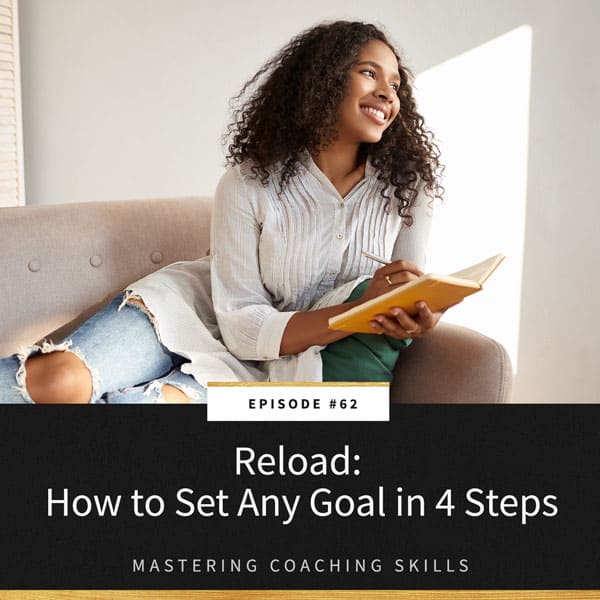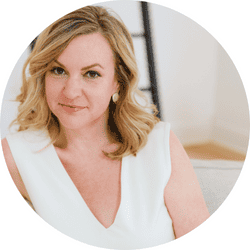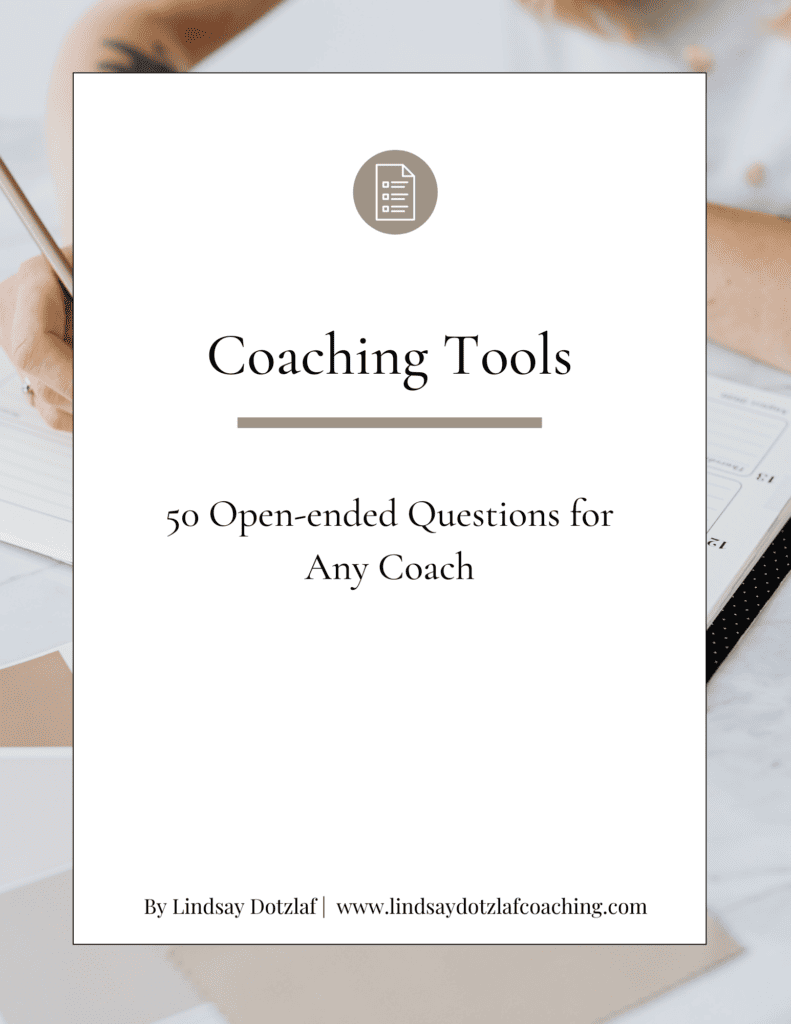With it being the very beginning of 2022, we’re revisiting a podcast that is perfect for this time of year. It’s one of my most-listened-to episodes, and it’s going to help you immensely in setting your goals and helping your clients set their goals for the next 12 months. So even if you’ve already heard it once, I invite you to listen again because this is such an important topic.
Goal setting is an area that so many coaches love to spend a lot of time in, but it’s ironically also where lots of you get stuck. There is so much confusion about how to set goals, especially when you’re unsure of how they would be measured, so I’m clearing up any confusion you might have with my simple four-step goal-setting process today.
Listen in this week as I bring you some clarity on the process of goal-setting, no matter what kind of coach you are. Learning this skill is going to allow you to guide your clients in a way that gets them mind-blowing results, so I urge you to follow this step-by-step.
If you want to take the work we’re doing here on the podcast and go even deeper, you need to join my six-month mastermind! Coaching Masters is now open for enrollment, so click here for more information or to sign up!
I am so excited to hear what you all think about the podcast – if you have any feedback, please let me know! You can leave me a rating and review in Apple Podcasts, which helps me create an excellent show and helps other coaches find it, too.
What You’ll Learn from this Episode:
- What I mean by “goals and math” and why this matters in measuring success.
- The 2 types of goals that your clients are going to come to you with.
- My 4-step goal-setting process.
- Why it’s important to help your clients set goals.
- How to measure progress when it comes to goals, even when they seem unmeasurable.
Listen to the Full Episode:
Featured on the Show:
- Coaching Masters is an exclusive, intimate, and powerful Mastermind that will NEXT LEVEL your coaching skills. Learn more here and join us!
- For even more resources on making your work as a coach and success for your clients easier, I’ve created a freebie just for you. All you have to do to get it is sign up to my email list at the bottom of the home page!
- Ep #6: How to Set Any Goal in 4 Steps
Full Episode Transcript:
Hi, this is Lindsay Dotzlaf and you are listening to Mastering Coaching Skills episode 62.
To really compete in the coaching industry, you have to be great at coaching. That’s why every week, I will be answering your questions, sharing my stories, and offering tips and advice so you can be the best at what you do. Let’s get to work.
Hello, happy New Year. I am so excited you are here. Welcome to the beginning of 2022. What? I don’t even know what happened to the last year. I think it just went so fast. In some ways it feels like it went so fast and in some ways it feels like the slowest year ever.
So, what we’re going to do today is go back and revisit a podcast that you may have already listened to, but it was one of my most listened to podcasts from this past year. And I think what’s really important about it and why it might be good for you to listen again, even if you’ve already listened, is that it’s all about goals, and setting goals, and four steps to goal setting.
And I think headed into a new year when you think about your goals for the year and you’re helping your clients set goals, it’s just good to revisit this and keep it in mind and go through the steps. So, I hope you enjoy it and I will be back next week with some brand new content, can’t wait. Enjoy.
The different ways that I break down coaching are awareness, goals and math, or creating your future, decisions, questions, and strategy. So today we’re going to talk about goals and math.
Goals and math are kind of the opposite of awareness. Awareness is where you are now, it’s your current state, it’s what you’re thinking and believing right now. It’s that you are here icon on a map. If you don’t know what I’m talking about, that was a reference I made in the last episode.
So now we’re going to move on to where you’re going. What are your goals and what is the math of the goals? This is just another type of coaching we can do with our clients and with ourselves and I find that goals and goal setting and working towards goals is where so many coaches love to spend a lot of time with their clients and it’s something they focus on a lot for themselves.
Ironically, it also seems to be the place where a lot of coaches get super confused. So hopefully today I will help you clear up some of that confusion. And when I say math, what I want you to kind of hear about that is that the way I define math might sound complicated but it’s not. It’s just any kind of measurement that you use along the way while you’re working towards a goal.
And listen carefully to this, no matter what kind of coach you are, your clients always have goals. So some of you right now might be thinking, oh, she’s going to talk about goals, but I’m not a business coach or I’m not a weight coach or I don’t have clearly defined goals in my coaching, that is okay.
So I’m going to tell you today why I think it’s still important to help your clients set goals and I’m going to help you know how to measure them, even when they’re not something that can be specifically measured by a number.
So the way I think about goals is literally any outcome you are working towards. So all of your clients will be working towards some type of outcome. It is why they have hired you. It is any result that they want or who they want to be, who they want to be in the future, and we can split goals really into two types.
So the first ones are super tangible and easily measurable, like I mentioned, making money, losing or gaining weight, finding love, something that either has a number or is very clear of yes, I have this, or no, I don’t.
The other kind of goal is going to be a little more abstract. So that might be something like feeling more confident or being less stressed or anything that might be defined by a feeling or something that just isn’t as measurable or as clear as something that includes a number.
This isn’t a problem. When I hired my first coach, it had nothing to do with numbers, I just wanted to feel better. I just wanted to learn how to not feel anxious, how to create what I wanted in my life, and how to really just make decisions and figure out who I wanted to be really.
So I think about setting goals as a four-step process. One, define the goal, two, decide how to measure it, three, break it up, and four, check in often. So when you’re working with your clients, the first step of setting goals, and this might actually be something that you even discuss on your first contact with a client.
So whether that’s a consult or something kind of depending on what type of coaching you’re selling, step one is deciding what the goal is. So for some of you, this will be super, super obvious. And it may even be defined by your niche.
So for example, if you are a coach that helps women over 50 lose 50 pounds or more, this first step will be pretty clear and easy. Your clients will come to you knowing what you do and that goal will already kind of be defined.
So when you talk to your clients, when you do this step, it’s really just going to be getting specific on what it looks like for them. What are the very specific parameters of this goal that they want to set, how long do they want it to take, what’s getting in the way, it’ll just be pretty clear.
If you are more of a general life coach and you coach clients on any and all aspects of their life, this conversation will look a little different because it will really be listening to your client. They might have multiple goals, you might help them create goals, you might even help them decide where to start, like which one are you going to do first?
And then if you work with your clients on something that’s a lot less measurable, do not skip this step, don’t think just I don’t know, mine isn’t measurable, I don’t really know, it’s still important to set the goal. So for you, this will just look like spending a little time here talking to them so you can both be very clear on what it is they’re wanting and how they want to get there.
And this will lead into the second step of setting goals, which is deciding how to measure them. This is also called math. This is just going to be how will we know if it’s working. And again, just like the first step for some of you, super clear. If you coach entrepreneurs and you teach them how to make money, the measure will be are they making money or not.
The math of the measurement will be the actual breakdown, how much money do they want to make, in how long, it will include lots of numbers. It will also be super clear if they’re hitting the goal or if they’re not. There are other niches that are also like this.
And again, if you coach your clients on something that’s a little more abstract, like I said a second ago, just don’t skip this. Don’t be scared of it, don’t gloss over it. Your coaching is going to be so much better if you lean into this. It’s not a bad thing that the goal isn’t as measurable. Now it just becomes your job as a coach to help your clients decide how can we measure this.
So I’m going to give you an example. Let’s say you’re a parenting coach and you help your clients have less anxiety and be more calm with their kids. You can decide upfront how will you know if it’s working. You can decide with your client. You can have them give you ideas. You can suggest some ideas.
Maybe you create a scale that your client uses every night before bed where she just picks a number one through 10 that measures one of the hardest parts of the day. So maybe it’s how much anxiety did she feel at dinnertime, or how much anxiety did she feel today while doing homework with the kids.
This is a simple example but I just want you to see that there are options and it doesn’t have to be something as tangible as money or weight or something that has a number. You can create this scale, you can create a number. So fun.
And it might be a little abstract, it might even feel abstract for your client, but that’s okay because the purpose of it, the purpose of having a measurement is just information. It doesn’t actually matter what the number is. You just want to have a way to show your client, is it working or is it not? It’s the same thing as looking at a map, I mentioned this earlier, where it’s like locating where am I now, where am I going?
Creating this measurement gives your brain or gives your client’s brain a way to look back at the map and say am I on the right track? Am I going in the right direction? Am I almost there? We wouldn’t have drama over that if we were looking at an actual map, but I have so many coaches that are like, oh no, I can’t do this part because there isn’t an actual measurement for what I do.
That’s not true. Just open up your brain and create one. You might get a little creative, you might try lots of different ways to measure. There’s no right or wrong and I want to kind of empower you to take the wheel here and say oh yeah, I could totally do this for my clients.
Or you could even do it with your clients. So if you’re a general life coach, or you just have clients that you coach on all different things, you don’t have to know what the measurement is going into a call. It’s just something you guys could spend a couple calls on really working out what is a way? How will I know if I’m getting results? How will your client know if she’s getting results?
So the third step is breaking up the goal. You want to break it up. This step is insanely important for a couple reasons, but especially if you’re working with a client for a longer period of time. So maybe you work with them for three months, six months, 12 months, whatever it is, and they have a really big goal. Something that requires a lot of growth on their part, something that requires a lot of changes that isn’t going to just be a breeze and feel easy the whole time.
So imagine if the success of the coaching hinges only on the one goal with a big measurement, there’s a good chance that they won’t believe it’s working until they’ve gotten all the way to the finish line because that’s how our brains work. Our brains love to be very binary; they love to be very black and white. Is it working, is it not working?
And if all of the focus is on this one goal and on the finish line the client just never gets the chance to believe it’s working along the way. So if you can break it up into smaller chunks, it allows them to have small wins. Or even if it’s not wins, maybe it’s not wins, maybe it’s actually not working, then they get to evaluate. Why is it not working? What changes can I make? What changes can you help them make as their coach?
It also creates a space where you can help them examine the goal and kind of decide if there are any changes that need to be made to the actual goal as you gather more information as you go. So if your client is working on something, if they have a goal that’s totally new to them, it’s something they’ve never done before, as they keep going, they’re going to gather more information.
Every call they’re going to come back – If they’re working towards their goal, every call they’re going to come back with more information, and sometimes it’s like, oh wow, this is way harder than I thought it was going to be, maybe I was shooting too big and I’m just going to tweak the goal slightly.
Or maybe I’m way ahead of schedule and I can tweak the goal in the other direction. I’m not saying always just go change your goals and change the circumstance to feel better. That’s not what I’m saying at all. But there are actual times when clients may set goals and we don’t actually know if they’ll work or not.
As we get more information, we can make more educated decisions on how long is this actually going to take? So when you’re working with clients on goals that can be measured by actual numbers, this will literally be math. So for example, how many clients do you have to sign at what price for how many months to make that goal happen, to hit that number that you’re wanting to hit by the end of the year.
In this step, what you would do is help them split that goal up into weeks, months, or quarters. And then if they have a goal that isn’t as easily divided up, maybe you create a different way to break it up. And don’t be afraid to play around with this and just explore the options of what might work for your clients.
Which brings me to step four, which is check in often. This is where I see all of the coaches have all of the drama. Because what if it’s not working? Or this one really makes me laugh, what if it’s working too fast? What if they’re not on track? What if they’re not hitting the goal? Or what if they’re way ahead of schedule? Then what are we going to do? What will we possibly coach on if they hit the goal and we still have months of a coaching package left?
It’s so fun usually to check in when your clients are nailing it, when they’re right on schedule, they’re doing exactly what you were hoping they would do, but what if they aren’t? One way or the other. They’re either not even close or they are just knocking it out of the park way ahead of schedule.
I want you to think about this. Avoiding talking about it altogether is the worst way to help them hit the goal. This is kind of like if you took a wrong turn on a road trip but you refuse to look at the map to see where you went wrong because you might not like what you see. That would be so silly, right?
How could you possibly course correct if you don’t look? You might be able to over time. You can drive around, you can figure it out, you can look at the signs, but wouldn’t it be so much faster if you just look at the map? We would mostly have no drama about that.
Unless of course you’re in the car with your husband and he doesn’t want to do it and all that. Just kidding. The nice thing about GPS is that my husband and I don’t ever fight about directions anymore because we just have GPS.
But I want to offer you this; that checking in is where you find all of the good juicy information. This is where the coaching gets really real. Because if you check in and things aren’t going well, this isn’t a problem at all. It’s not a problem for you, it’s not a problem for your client, it’s just information.
You can gather the information and you can keep moving forward. You can examine the thoughts and the feelings they are having and that are getting in the way. You may even just go back to the awareness piece like we talked about last week.
Maybe they’ve discovered some thoughts or you help them, as their coach, discover some thoughts they have maybe about themselves that need to be worked out before they can keep going.
Like I said earlier, the other place I see this happening is when coaches think, oh my gosh, what if my clients are hitting their goals too fast? Which I do always get a laugh out of this because truly, this is what your clients want. Your clients are paying you for results. Not for coaching sessions. Think about that.
When your clients hire you, they are paying you for results. Do you actually think they’re going to be upset if they’re getting results faster than they thought they would? No, they will love it.
I’m going to answer this really quickly for you, what to do when your clients are killing it and getting fast results. The exact same thing you do when they aren’t. What? It might look a little different, but you can go back to awareness, right where you are, and help them see right where they are. Help them see what are the thoughts you’re having? What are the feelings you’re experiencing? What are the actions you’re taking? How are you creating this result?
Because if they can see it and they can truly understand that, then they’re able to replicate it in the future. That’s so much more fun than yeah, I’m killing it, I don’t really know how, it’s all a fluke. I know so many of my clients have those thoughts a lot of the time, like this is all a fluke.
Then we spend time, I’m like hold on, let’s back up a minute. You’re killing it, it cannot be a fluke. Let’s really examine how you’re creating these results. And it just gets to be fun.
This is the piece where coaching gets to be fun. It doesn’t always have to be heavy, it doesn’t always have to be oh my gosh, everything is going wrong. Sometimes it can be things are going great, let’s celebrate. Also there’s something you can do. But let’s celebrate it but let’s also spend some time looking at why is it working. That’s really fun.
So to sum it up, here are the steps. Set the goals, decide how to measure them, break them up, and check in often. And remember, this can be used with your clients, but it can also be used in your self-coaching. It’s the best way to get better at setting goals and it’s the best way at being a great coach for your clients and helping them hit the goals that they set when they hire you.
So take these steps and make them your own. I’m teaching you what I have learned over my coaching career. I’ve learned from other people, I’ve learned from my coaches, but then I’ve taken all of it, like, how can I make this work for me?
So decide how these steps can work for you, how it can work for your clients, and get to it. And then let me know what you think.
Thanks for listening to this episode of Mastering Coaching Skills. If you want to learn more about my work, come visit me at lindsaydotzlafcoaching.com. That’s Lindsay with an A, D-O-T-Z-L-A-F.com. see you next week.
Enjoy the Show?
- Don’t miss an episode, follow the podcast on Spotify and subscribe via Apple Podcasts, Stitcher or RSS.
- Leave me a review in Apple Podcasts.
- Join the conversation by leaving a comment below!







